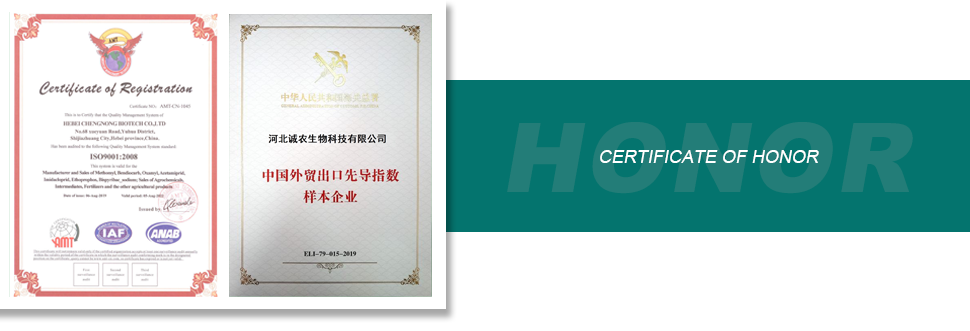
Sep . 26, 2024 01:29 Back to list
chlorpyrifos pubchem
Understanding Chlorpyrifos A Comprehensive Overview
Introduction
Chlorpyrifos is an organophosphate insecticide that has been widely used in agriculture to manage a variety of pests. It is known for its effectiveness in controlling insects on crops such as corn, soybeans, and various fruits and vegetables. However, its use has raised significant environmental and health concerns, leading to ongoing debates about its safety and regulation. This article aims to provide an in-depth understanding of chlorpyrifos, its applications, risks, and regulatory status.
Chemical Properties
Chlorpyrifos, chemically known as O,O-diethyl O-(3,5,6-trichloro-2-pyridyl) phosphorothioate, was first registered for use in the United States in 1965. It functions as an acetylcholinesterase inhibitor, disrupting neurotransmission in insects, thereby leading to paralysis and death. This biochemical mechanism is responsible for its potent insecticidal properties. Chlorpyrifos is typically applied in granular or liquid formulations, and its persistence in the environment can vary based on soil composition and climatic conditions.
Applications in Agriculture
Chlorpyrifos has been utilized in a wide range of agricultural settings. Farmers appreciate its ability to combat pests that threaten crop yields, such as aphids, beetles, and caterpillars. Its efficacy against a broad spectrum of insects makes it a popular choice in integrated pest management strategies. However, the reliance on chlorpyrifos for pest control has also led to the development of resistance among target pest species, prompting farmers to seek alternative solutions.
Health and Environmental Concerns
chlorpyrifos pubchem

One of the most contentious aspects of chlorpyrifos is its potential impact on human health. Studies have linked exposure to chlorpyrifos, particularly among agricultural workers and communities near treated fields, to neurodevelopmental issues in children, including lowered IQ and developmental delays. Additionally, exposure has been associated with respiratory issues and other health risks. Due to these concerns, various organizations, including the Environmental Protection Agency (EPA), have conducted reviews to assess the safety of chlorpyrifos.
Aside from direct health impacts, chlorpyrifos poses significant environmental risks. It can accumulate in aquatic ecosystems, leading to toxicity in fish and other wildlife. The pesticide can also affect non-target insects, including beneficial pollinators like bees, thereby disrupting the ecological balance. Continued use of chlorpyrifos has raised alarms among environmental advocates calling for more sustainable pest control practices.
Regulatory Actions and Public Perception
The regulation of chlorpyrifos has been a focal point of advocacy groups, farmers, and policymakers. In 2015, the EPA proposed a ban on most agricultural uses of chlorpyrifos, citing the growing body of evidence regarding its risks to human health and the environment. However, this ban faced political challenges, and in 2020, the EPA announced that it would not ban the pesticide, a decision that generated significant backlash from public health organizations.
Public perception of chlorpyrifos is increasingly negative, driven by growing awareness of its associated risks. Many consumers are now advocating for the elimination of harmful chemicals in food production, leading to shifts in market demands towards organic and pesticide-free produce. Various states have taken action independently, with California being one of the first to announce a ban on chlorpyrifos in 2020.
Conclusion
Chlorpyrifos remains a notable example of the complexities surrounding pesticide use in modern agriculture. While it has proven effective in managing agricultural pests, the associated health and environmental risks cannot be overlooked. As scientific research continues to expand our understanding of its impacts, the conversation around chlorpyrifos will likely evolve. Ultimately, balancing agricultural productivity with public health and environmental sustainability will be key to progressing towards a more responsible and safe agricultural future. Further research and innovation in pest management will be necessary to find effective alternatives that minimize risks while ensuring food security.
-
Vexis Herbicide – Advanced Selective Control, Compare with Tenacity 8oz Mesotrione Selective & Non-Selective Solutions
NewsJun.24,2025
-
Dicamba Herbicide for Creeping Charlie – Effective & Selective Weed Control Solution
NewsJun.10,2025
-
Premium Penthiopyrad Fungicide for Effective Crop Protection Compare with Carbendazim & Copper Fungicides
NewsJun.10,2025
-
Top Products Containing Bifenthrin Effective Insecticide Solutions
NewsJun.10,2025
-
Powerful Lambda Cyhalothrin & Emamectin Benzoate Insecticide
NewsJun.10,2025
-
Emamectin Benzoate 5% Wholesale Supplier - Premium Quality
NewsJun.10,2025
